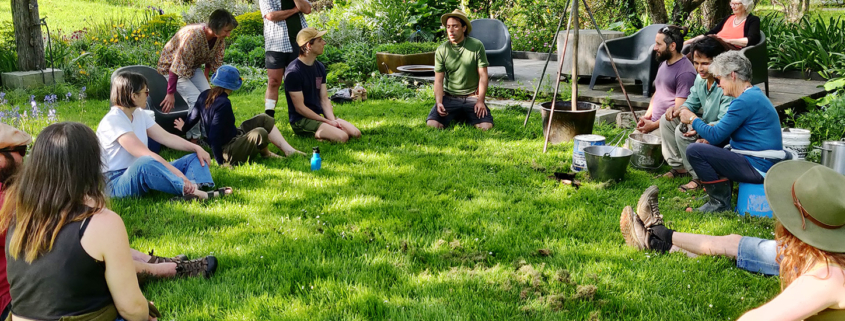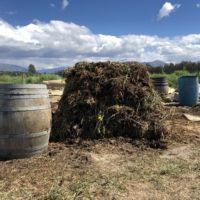Biodynamic Gardening In An Urban School
Harvests Magazine Article – Summer 2016
Jen Speedy manages the gardens at Taikura Rudolf Steiner School, and assists with the Taruna Certificate in Applied Organics and Biodynamics.
It’s a busy bustling life, that of the school garden.
The school year begins in late summer, after a six week rest for the garden from the activity of children, teachers and school people. I’m sure our school gardens rejoice when term begins, with the renewed activity and the return to rhythm.
We use the biodynamic calendar in our gardening activities and our general work over the three-acre grounds, as well as when we work alongside the children of the lower school in their gardening.
Our school is located in sunny Hawkes Bay, in the heart of Hastings city, right next door to Heinz-Watties. I am very fortunate to care for our school gardens with co-gardener and friend Jo-Anne Doig.
We are blessed with the rich, very fertile soils of the Heretaunga Plains. Our school is Taikura Rudolf Steiner School, founded originally as Queenswood Rudolf Steiner School in 1950. The first applications of preparation 500 were applied then, and the varied and beautiful gardens have been biodynamically cared for ever since. Just imagine 66 years of having preparation 500 joyfully, noisily, and lovingly applied. Sixty-odd years of the uplifting, sparkling light-filled mists of preparation 501 and lavish dressings of biodynamic composts. The blackbirds and thrushes are not the only ones who can hear the worms; the soil is so rich with life, and digging into soil is like slicing through butter.
Just imagine 66 years of having preparation 500 joyfully, noisily, and lovingly applied.
Jen Speedy
Taikura’s gardens are a holistic support system for the children; they not only provide a beautiful and safe environment in an urban setting, but are also used for education and enjoyment.
The grounds have increased in area over the years with the addition of Scannell’s Garden. Scannell’s is a woodland garden treasure with century-old trees, cool shady pathways, an open sunny lawn and a woodwork room. Thanks to the help of the children, there is much wood chip mulch under the trees to protect tree roots and retain moisture and soil life.
Bark-mulching these pathways also defines them, helping keep the ornamental gardens safe from playful children, although not always from the odd stray ball.
More recently, the school grew into a neighbouring office block. The challenge here was to enliven what was previously a sealed carpark. Now, four years on, what was once a hard, compacted, stony ground is a thriving garden – the clear result of hard work by Class 3 children digging over the ground, adding many barrow-loads of biodynamic compost, applying preparation 500, sowing green crops of lupins and barley, mustard and broad beans, and many dressings of cowpat pit and light mulchings of lawn clippings.
There are yearly themes in Steiner education, and in Class 3 (around nine years old), one is the study of how people work in the world. The children learn particularly about basic things that are sometimes taken for granted, such as how we obtain food and shelter. This leads naturally to them working in the garden
As an urban garden, the school is on the town water supply. We have a good-sized tank of rainwater specifically used for biodynamic preparations (and which also proves useful in times of drinking water crisis….)
The Annual Cycle
When the summer draws to a close and before our plants are fully ripened, we like to give a thank you application of preparation 501, a time we think suits our varied gardens.
This is a quiet and gentle activity with a small group of parents, teachers and friends enjoying the dawn of the new day, stirring and releasing light filled mists over our loved grounds.
With the children, our garden year starts by harvesting corn, tomatoes, beans, courgettes, eggplants, and sunflowers, along with herbs that they will use when cooking at the cob ovens. We then compost the gardens, plant winter crops such as leeks, kale, cabbages and broccoli, and sow broad beans. Some gardens are sown with green crops for later digging-in and replanting.
In the autumn, we stir and spread preparation 500; we create lasagne-style hot biodynamic compost heaps; we make the cowpat pit; and we fill cow horns with cow manure and bury 40 of them in the whare garden. With three acres of grounds, we have a good supply of materials such as leaves, lawn clippings, crop refuse, weeds and food scraps (from school lunches) for composting. The cow manure is collected from the cow pastures at Hohepa Farm and from Jo-Anne’s two cows at her farm. Our compost preparations are bought from the Biodynamic Association.
Our winter activities include turning the composts, mixing and aerating the cowpat pit, and gifting our trees with tree paste – a much-enjoyed activity completed with exuberance by all.
It’s spring as I write this, and we harvested the cowpat pit and have carefully lifted the cow horns. The children share much surprise over what comes out of the cow horns; it no longer looks, feels or smells like the cow manure that they originally put in. Together we have stirred and spread the cow horn manure (preparation 500) over our grounds.
The children are sowing seeds into their well-composted and prepared gardens. The green crops are dug in, and once the frosts have passed, the children plant out their tomato, courgette, corn, eggplant, watermelon and pumpkin seedlings, which they have grown themselves from seed in the classrooms and glasshouse.
The children enjoy the practical use of the gardens, cooking and sharing their produce.



